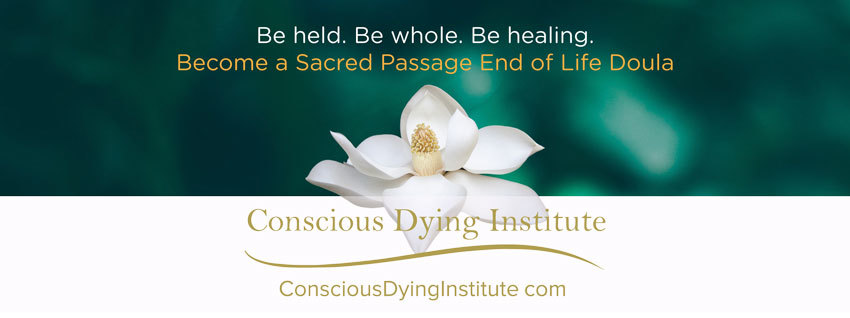Ceremony When the Body is Removed: Leave Taking
In the Presence of Death: Using ceremony to explore mindfulness in the journey of dying, death, and the years following, in this 9-part series
jacoblund/Thinkstock
When the body of someone you care about is being removed from the place of death to the next place is a moment that usually catches people unawares. It’s big.
Marking it with ceremony is what can speak to this sort of painful transition. Use true, sincere ceremony – a form of presence, of witnessing – to call into the open that which is happening right now, in this moment.
It was a dog and a man who showed me how to be fully present, and in a way that shifted us from the grip of not wanting to let go, to a softening release.
Grandmother Gladys leaves home forever
Gladys was 92 when she died at home in the special recliner that was the center of her world, her tv remote, phone, books and sewing piled on the tables on either side of the chair for the last five years of her life.
She had lived downstairs from her devoted family for 25 years, who tended to her more and more as she declined. After a final illness, with Hospice care, she died at 9:30 at night, and the funeral home agreed to send their ‘removal man’ at 8:30 the next morning.

My little dog Luna and I had lived with Gladys for her final months. Together, the family and I cleared the room of medicines and oxygen machines, and tended to her as we began to ready ourselves to send her off. We brushed her hair, and put her favorite crystal in her hand. In the other, a poesy of rosemary and herbs from her garden. Someone made an altar of family photos, candles, and flowers.
When morning came, we gathered quietly and sadly around her chair. The realization that soon she would leave forever, this place that had been her world, filled the room with a heavy air. It was tense. It was hard.
I asked for a moment to make a blessing of gratitude to the home that had sheltered her, which brought comfort as we stood within it, acknowledging all that had happened under its safe roof.
“Gladys has been the heart of this sweet home for many years, the last in her remarkable life. Here she has created paintings, guided with great wisdom and humor her friends and family in their journeys, named the birds, eaten from the garden. This home and the love within it have been her safe harbor. She has laughed and cried, been angry and brilliant, ill and recovered within its walls. We are very grateful to this sheltering place, and that she was able to die here, as she wished. Thank you House and Home and Garden and Birds and Loving Family, for all that you have given to her, and continue to give to us. As she leaves on her last trip, we ask for your blessing on her way.”
The doorbell rang and we jumped. We weren’t ready to see her leave. Yet this ‘removal man’ brought with him a deep gentleness, consideration, and sense that we had all the time in the world. He was quiet, sincere, and very present. As he came to Gladys’ door, Luna barked a warning and ran to the chair that held her body. She stood her ground. This wasn’t something I had witnessed before. She clearly was saying, ‘Stay away from my Grandmother.’
The man stopped at the door, and knelt. He didn’t try to come closer. He told us that it is always like this: a cat will refuse to leave their human’s lap; a dog will stand guard. He asked her name, and then quietly began talking to her.
“Luna, I know that you’re upset. That you’re grieving the death of your friend. This is hard on you and your family. Still, it’s time for Gladys to leave home now. I know you’re concerned. But I want you to know that I will be very gentle with her, and I will take very, very good care of her. We will watch over her all the way to the end.”
As he talked, she began to relax. He offered his hand, still kneeling, and she slowly walked across the room to sniff it.
In her body, she felt understood. And she was able to release her dear friend.
Both the man and the dog were showing us the way to let go, to let Gladys move on. They showed us, with grace and compassion, that simply naming what is going on right now is a form of ceremony.
He asked if anyone wanted to help him. As they gently carried her to the stretcher and slowly pushed it down the hall, Luna followed behind. It was clear that Gladys would be tenderly and carefully attended to, and we could say a sad, and peaceful goodbye.
Funeral Director Amy Cunningham has addressed the need in her industry for the removal people to take time to add mindfulness to this transition in From Perfunctory Transfer to Transformative Experience. It’s worth considering passing this along to any funeral directors you know.
Whether you’re saying goodbye in a family home or hospital room, simple ceremony is important to sanctify the importance of this transition. What you can do:
- Soften and clear the room as much as you are able.
- Set your intention to be mindful as you prepare to say goodbye to the labor of dying.
- Acknowledge that what is about to happen is difficult, and final. Speak your feelings out loud.
- Say a blessing of gratitude to the space itself.
- Ask the removal people to go slowly. When it’s time to move the body from the room, ask for the time you need to say your final goodbyes.
- Feel free to play music, to sing, to read a poem or blessing.
Here are some poems you could look at in this time, including ‘Blessing for Leaving.’
Find ‘Moving the Body’ readings, poetry, and prayers on the InspiredFuneral.com, a resource co-edited by Funeral Director Amy Cunningham and Funeral Celebrant Kateyanne Unullisi.


